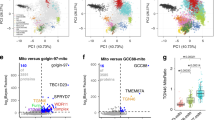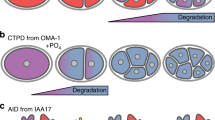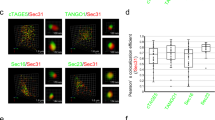Abstract
There is a debate over how protein trafficking is performed through the Golgi apparatus1,2,3,4. In the secretory pathway, secretory proteins that are synthesized in the endoplasmic reticulum enter the early compartment of the Golgi apparatus called cis cisternae, undergo various modifications and processing, and then leave for the plasma membrane from the late (trans) cisternae. The cargo proteins must traverse the Golgi apparatus in the cis-to-trans direction. Two typical models propose either vesicular transport or cisternal progression and maturation for this process. The vesicular transport model predicts that Golgi cisternae are distinct stable compartments connected by vesicular traffic, whereas the cisternal maturation model predicts that cisternae are transient structures that form de novo, mature from cis to trans, and then dissipate. Technical progress in live-cell imaging has long been awaited to address this problem. Here we show, by the use of high-speed three-dimensional confocal microscopy, that yeast Golgi cisternae do change the distribution of resident membrane proteins from the cis nature to the trans over time, as proposed by the maturation model, in a very dynamic way.
This is a preview of subscription content, access via your institution
Access options
Subscribe to this journal
Receive 51 print issues and online access
$199.00 per year
only $3.90 per issue
Buy this article
- Purchase on Springer Link
- Instant access to full article PDF
Prices may be subject to local taxes which are calculated during checkout




Similar content being viewed by others
References
Glick, B. S. & Malhotra, V. The curious status of the Golgi apparatus. Cell 95, 883–889 (1998)
Pelham, H. R. B. & Rothman, J. E. The debate about transport in the Golgi—two sides of the same coin? Cell 102, 713–719 (2000)
Pelham, H. Getting stuck in the Golgi. Traffic 1, 191–192 (2000)
Pelham, H. R. B. Traffic through the Golgi apparatus. J. Cell Biol. 155, 1099–1101 (2001)
Nakano, A. Spinning-disk confocal microscopy—a cutting-edge tool for imaging of membrane traffic. Cell Struct. Funct. 27, 349–355 (2002)
Preuss, D. et al. Characterization of the Saccharomyces Golgi complex through the cell cycle by immunoelectron microscopy. Mol. Biol. Cell 3, 789–803 (1992)
Rambourg, A., Clermont, Y. & Képès, F. Modulation of the Golgi apparatus in Saccharomyces cerevisiae sec7 mutants as seen by three-dimensional electron microscopy. Anat. Rec. 237, 441–452 (1993)
Rossanese, O. W. et al. Golgi structure correlates with transitional endoplasmic reticulum organization in Pichia pastoris and Saccharomyces cerevisiae. J. Cell Biol. 145, 69–81 (1999)
Nakano, A. Yeast Golgi apparatus—dynamics and sorting. Cell. Mol. Life Sci. 61, 186–192 (2004)
Sato, K., Sato, M. & Nakano, A. Rer1p as common machinery for the endoplasmic reticulum localization of membrane proteins. Proc. Natl Acad. Sci. USA 94, 9693–9698 (1997)
Sato, K., Sato, M. & Nakano, A. Rer1p, a retrieval receptor for endoplasmic reticulum membrane proteins, is dynamically localized to the Golgi apparatus by coatomer. J. Cell Biol. 152, 935–944 (2001)
McNew, J. A. et al. Gos1p, a Saccharomyces cerevisiae SNARE protein involved in Golgi transport. FEBS Lett. 435, 89–95 (1998)
Bevis, B. J., Hammond, A. T., Reinke, C. A. & Glick, B. S. De novo formation of transitional ER sites and Golgi structures in Pichia pastoris. Nature Cell Biol. 4, 750–756 (2002)
Campbell, R. E. et al. A monomeric red fluorescent protein. Proc. Natl Acad. Sci. USA 99, 7877–7882 (2002)
Hardwick, K. G. & Pelham, H. R. SED5 encodes a 39-kD integral membrane protein required for vesicular transport between the ER and the Golgi complex. J. Cell Biol. 119, 513–521 (1992)
Wooding, S. & Pelham, H. R. B. The dynamics of Golgi protein traffic visualized in living yeast cells. Mol. Biol. Cell 9, 2667–2680 (1998)
Achstetter, T., Franzusoff, A., Field, C. & Schekman, R. SEC7 encodes an unusual, high molecular weight protein required for membrane traffic from the yeast Golgi apparatus. J. Biol. Chem. 263, 11711–11717 (1988)
Sata, M., Donaldson, J. G., Moss, J. & Vaughan, M. Brefeldin A-inhibited guanine nucleotide-exchange activity of Sec7 domain from yeast Sec7 with yeast and mammalian ADP ribosylation factors. Proc. Natl Acad. Sci. USA 95, 4204–4208 (1998)
Letourneur, F. et al. Coatomer is essential for retrieval of dilysine-tagged proteins to the endoplasmic reticulum. Cell 79, 1199–1207 (1994)
Rambourg, A., Clermont, Y., Ovtracht, L. & Kepes, F. Three-dimensional structure of tubular networks, presumably Golgi in nature, in various yeast strains: a comparative study. Anat. Rec. 243, 283–293 (1995)
Rambourg, A., Jackson, C. L. & Clermont, Y. Three dimensional configuration of the secretory pathway and segregation of secretion granules in the yeast Saccharomyces cerevisiae. J. Cell Sci. 114, 2231–2239 (2001)
Marsh, B. J., Volkmann, N., McIntosh, J. R. & Howell, K. E. Direct continuities between cisternae at different levels of the Golgi complex in glucose-stimulated mouse islet beta cells. Proc. Natl Acad. Sci. USA 101, 5565–5570 (2004)
Trucco, A. et al. Secretory traffic triggers the formation of tubular continuities across Golgi sub-compartments. Nature Cell Biol. 6, 1071–1081 (2004)
Losev, E. et al. Golgi maturation visualized in living yeast. Nature advance online publication, doi:10.1038/nature04717 (14 May 2006)
Acknowledgements
We thank all the members of the Nakano group of the Dynamic-Bio Project for the accomplishment of this microscopy project; Yokogawa Electric Corporation, NHK (Japan Broadcasting Corporation), NHK Engineering Service, Hitachi Kokusai Electric, and the Research Association for Biotechnology for their contributions; R. Tsien for the distribution of mRFP; Olympus Corporation for technical help; and B. Glick for exchange of information before publication. This work was supported by national funds from the Ministry of Economy, Trade and Industry of Japan and the New Energy and Industrial Technology Development Organization, partly by Grants-in-Aid from the Ministry of Education, Culture, Sports, Science and Technology of Japan, and partly by the funds from the Bioarchitect, the Real-Time Bionanomachine and the Extreme Photonics Projects of RIKEN.
Author information
Authors and Affiliations
Corresponding author
Ethics declarations
Competing interests
Reprints and permissions information is available at npg.nature.com/reprintsandpermissions. The authors declare no competing financial interests.
Supplementary information
Supplementary Figure 1
This figure shows a model of Golgi maturation. (PDF 440 kb)
Supplementary Figure 2
This figure shows the effects of traffic mutations on the localization of Golgi markers. (PDF 320 kb)
Supplementary Figure 3
This figure shows frequent change of color in cells expressing GFP–Gos1p (medial, green) and Sec7p–mRFP (trans, red). (PDF 909 kb)
Supplementary Video 1
Wild-type yeast cells expressing GFP–Rer1p (cis, green) and mRFP-Gos1p (medial, red). 20x real time. (MOV 2709 kb)
Supplementary Video 2
ret1-1 cells expressing GFP–Gos1p (medial,green) and Sec7p–mRFP (trans, red). 10x real time. (MOV 869 kb)
Supplementary Video 3
Another example of ret1-1 cells expressing GFP–Gos1p (medial,green) and Sec7p–mRFP (trans, red). 10x real time. (MOV 769 kb)
Supplementary Video 4
3D observation of wild-type yeast cells expressing mRFP–Sed5p (cis, red) and Sec7p–GFP (trans, green). 5x real time. (MOV 984 kb)
Supplementary Video 5
Another example of 3D movie showing wild-type yeast cells expressing mRFP-Sed5p and Sec7p–GFP. 14x real time. (MOV 621 kb)
Supplementary Video 6
3D deconvolution observation of yeast expressing mRFP–Gos1p and Sec7p–GFP. 25x real time. (MOV 926 kb)
Supplementary Video 7
Another example of 3D deconvolution movie. 25x real time. (MOV 1098 kb)
Rights and permissions
About this article
Cite this article
Matsuura-Tokita, K., Takeuchi, M., Ichihara, A. et al. Live imaging of yeast Golgi cisternal maturation. Nature 441, 1007–1010 (2006). https://doi.org/10.1038/nature04737
Received:
Accepted:
Published:
Issue Date:
DOI: https://doi.org/10.1038/nature04737
This article is cited by
-
Rab GTPases and phosphoinositides fine-tune SNAREs dependent targeting specificity of intracellular vesicle traffic
Nature Communications (2024)
-
Impaired biosynthesis of ergosterol confers resistance to complex sphingolipid biosynthesis inhibitor aureobasidin A in a PDR16-dependent manner
Scientific Reports (2023)
-
Retro-2 alters Golgi structure
Scientific Reports (2022)
-
RAB GTPases and SNAREs at the trans-Golgi network in plants
Journal of Plant Research (2022)
-
A new pH sensor localized in the Golgi apparatus of Saccharomyces cerevisiae reveals unexpected roles of Vph1p and Stv1p isoforms
Scientific Reports (2020)
Comments
By submitting a comment you agree to abide by our Terms and Community Guidelines. If you find something abusive or that does not comply with our terms or guidelines please flag it as inappropriate.



